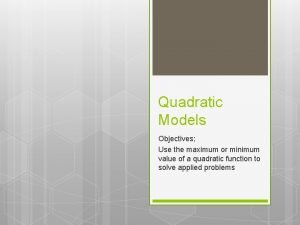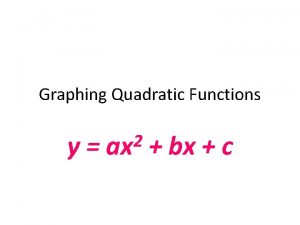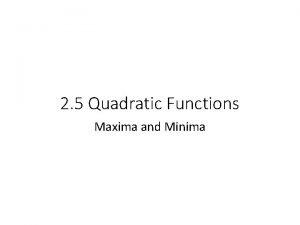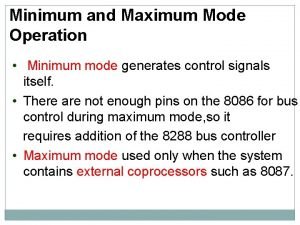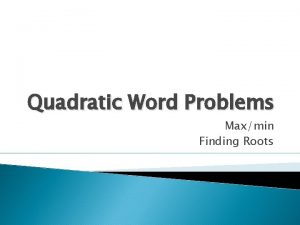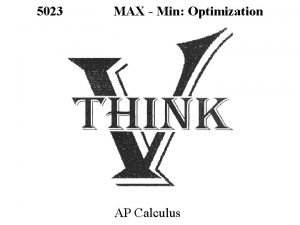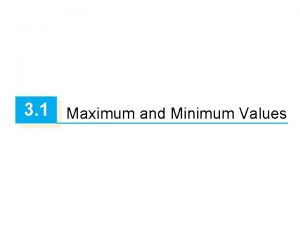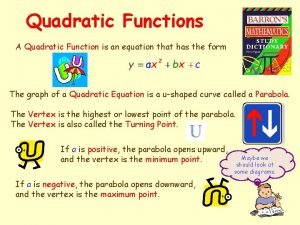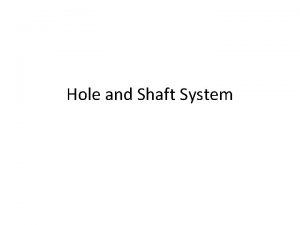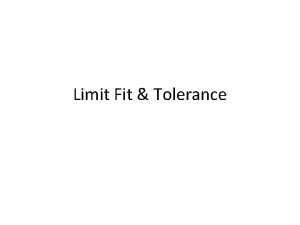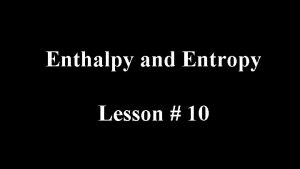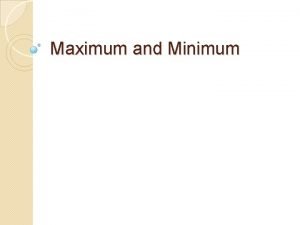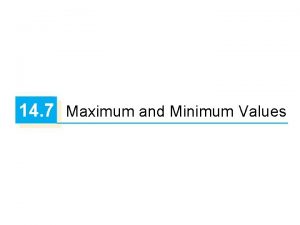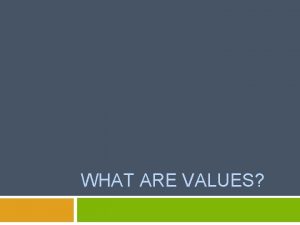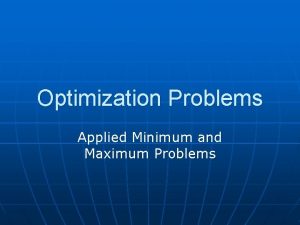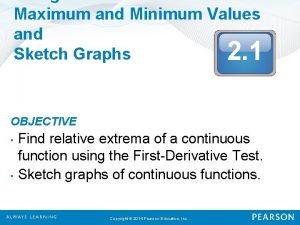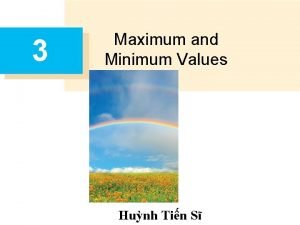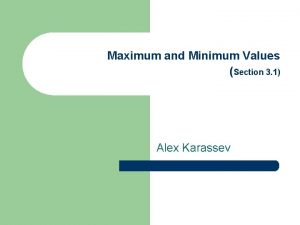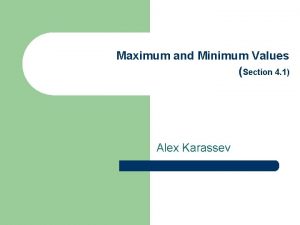Lesson 4 1 Maximum and Minimum Values Quiz




![Theorems Extreme Value Theorem: If f is continuous on the closed interval [a, b], Theorems Extreme Value Theorem: If f is continuous on the closed interval [a, b],](https://slidetodoc.com/presentation_image_h/8770e8e462dbb94f80f12e6e994da67f/image-5.jpg)







- Slides: 12

Lesson 4 -1 Maximum and Minimum Values

Quiz • Homework Problem: Related Rates 3 -10 Two cars start moving from the same point. One travels south at 60 mph and the other travels west at 25 mph. At what rate is the distance between the cars increasing two hours later. • Reading questions: – What were the names of the two theorems in section 4. 1? – What happens at a critical number?

Objectives • Understand extreme values of a function • Find critical values of a function • Find extreme values of a function

Vocabulary • Absolute maximum – a value greater than or equal to all other values of a function in the domain • Absolute minimum – a value less than or equal to all other values of a function in the domain • Critical number – a value of x such that f’(x) = 0 or f’(x) does not exist • Extreme values – maximum or minimum functional values • Local maximum – a value greater than or equal to all other functional values in the vicinity of a value of x • Local minimum – a value less than or equal to all other functional values in the vicinity of a value of x • Maximum value – the value of the function than is greater than or equal to all other values of the function • Minimum value – the value of the function than is less than or equal to all other values of the function
![Theorems Extreme Value Theorem If f is continuous on the closed interval a b Theorems Extreme Value Theorem: If f is continuous on the closed interval [a, b],](https://slidetodoc.com/presentation_image_h/8770e8e462dbb94f80f12e6e994da67f/image-5.jpg)
Theorems Extreme Value Theorem: If f is continuous on the closed interval [a, b], then f attains an absolute maximum value f(c) and a absolute minimum value f(d) at some numbers c and d in [a, b]. Fermat’s Theorem: If f has a local maximum or minimum at c, and if f’(c) exists, then f’(c) = 0. Or rephrased: If f has a local maximum or minimum at c, then c is a critical number of f. [Note: this theorem is not biconditional (its converse is not necessarily true), just because f’(c) = 0, doesn’t mean that there is a local max or min at c!! Example y = x³]

Closed Interval Method: To find the absolute maximum and minimum values of a continuous function f on a closed interval [a, b]: 1. Find the values of f at the critical numbers of f in (a, b) (the open interval) 2. Find the values of f at the endpoints of the interval, f(a) and f(b) 3. The largest value from steps 1 and 2 is the absolute maximum value; the smallest of theses values is the absolute minimum value.

Example 1 Find the relative and absolute extrema for each of the following: f(x) = -2 x³ + 3 x² f’(x) = -6 x² + 6 x = 6 x(-x + 1) = 6 x(1 – x) f’(x) = 0 or undefined when x = 0 or x = 1 f(0) = 0 and f(1) = 1 these are relative extrema Since f(x) goes to ± ∞ as x → ± ∞ there are no absolute extrema

Example 2 Find the relative and absolute extrema for each of the following: Closed Interval: 1) Evaluate critical numbers f(x) = x⅔ on [-1, 2] 2) Evaluate end points f’(x) = ⅔x-⅓ f’(x) = 0 or undefined when x = 0 f(0) = 0 this is an extrema Since f(x) at the end points is f(-1) = 1 and f(-2) = 4⅓ = 1. 59 that makes f(0) and f(-2) absolute extrema and f(-1) a relative extrema

Example 3 Find the relative and absolute extrema for each of the following: f(x) = (1 + x²)‾¹ f’(x) = -2 x / (1+x²)² f’(x) = 0 (or undefined) when x = 0 f(0) = 1 this is an absolute extrema

Example 4 Find the relative and absolute extrema for each of the following: Closed Interval: f(x) = sin x – cos x on [0, π] 1) Evaluate critical numbers 2) Evaluate end points f’(x) = cos x + sin x f’(x) = 0 or undefined when sin x = -cos x or at ¾π f(¾π) = 2 = 1. 414 this is an extrema Since f(x) at the end points is f(0) = -1 and f(π) = 1 that makes f(0) and f(¾π) absolute extrema and f(π) a relative extrema

Calculator Summary F 3 gets to function d() that allows us to take the derivative syntax: d(function, variable) F 2 gets to zeros function that allows us to find the zeros of an equation syntax: zeros(function, variable) | key allows use to evaluate a function at a point syntax: function | variable = value F 6 gets us to put in functions in form of Y = to graph using F 8. If we need to adjust the window we use F 7

Summary & Homework • Summary: – A critical number is one where the first derivative is zero or undefined – Relative extrema occur only at critical numbers. – Absolute extrema occur at relative extrema or at the endpoints of the interval. • Homework: – pg 285 – 288: 1, 4, 6, 9, 31, 35, 36, 53, 57, 74
 Absolute min and max
Absolute min and max Maximum and minimum values of quadratic functions
Maximum and minimum values of quadratic functions What is the opening of the quadratic function y = -4x^2?
What is the opening of the quadratic function y = -4x^2? Maximum and minimum values of quadratic functions
Maximum and minimum values of quadratic functions Which is not the output signal of the bus controller 8288?
Which is not the output signal of the bus controller 8288? Maximum and minimum word problems
Maximum and minimum word problems Optimization problems maximum and minimum
Optimization problems maximum and minimum Maximum and minimum derivative
Maximum and minimum derivative Extreme value theorem
Extreme value theorem Example of quadratic function
Example of quadratic function Transition fit
Transition fit Minimum metal condition (lml) corresponds to the
Minimum metal condition (lml) corresponds to the Minimum enthalpy and maximum entropy
Minimum enthalpy and maximum entropy

